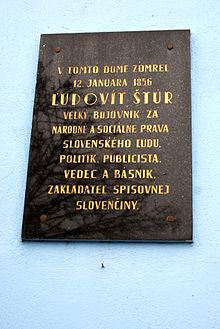Modra
Modra (Template:Lang-de, Template:Lang-hu, Latin: Modur) is a city and municipality in the Bratislava Region in Slovakia. It has a population of 8,704 as of 2005[update]. It nestles in the foothills of the Malé Karpaty (Little Carpathian mountains) and is an excellent centre of hiking.
Modra is famous for its pottery industry. Its blue-and-white porcelain is famous throughout Slovakia. It is also known as one of the most important viticulture centres in the Little Carpathians region.
Besides the main town, there are also other adjacent settlements incorporated in the municipality: former vassalage viticulture village Kráľová and two recreational hamlets of Harmónia and Piesok (also known as Zochova Chata), both located in the woods of Little Carpathians mountains.
Etymology
Most experts agree that the name is connected to Template:Lang-sk (blue).[1] The name probably originates from another historic geographic name in the neighbourhood, e.g. Modrá hora (Blue Mountain). According to a less probable hypothesis, the name comes from Template:Lang-hu (a bird).[1]
History
The first traces of habitation go back into the 3rd millennium BCE and the first permanent habitation comes from the time of Great Moravia, when the Slavs were living there. The first mention about Modra was in 1158 in a document of the Géza II of Hungary, when it belonged to the bishop of Nitra. After the Mongol invasion of 1241 the settlement was reconstructed by the German colonists. The first mention about vineyards goes back to 1321. The settlement received its town privileges in 1361 and became a free royal town in 1607. The town fortifications with three gates were constructed in 1610–1647. Since the 17th century it was one of the leading craft centres in present-day Slovakia. The ceramic industry and majolica production started in the 19th century and in 1883 a school of ceramics was established, where through the skillfulness of Habaners the so-called Slovak ceramics were created. The railway track from Bratislava to Trnava bypassed the town in the 1840s, as the local magistrate refused to allow construction of the railway.
Landmarks
- Modra Observatory of the Comenius University in Bratislava near Modra-Piesok
- A grave memorial museum (with an external exhibition "Štúrova izba" (memorable room of Štúr) and statue of Ľudovít Štúr, who died here in 1856
- Remains of the former fortifications: a bastion (with a gallery of Ignác Bizmayer, pottery master) and the "Upper Gate", the only one of three original town gates to be preserved
- A country castle just behind the upper gate; seat of the vineyard school
- A Renaissance building from the end of the 17th century
- the present-day workshops specialising on the Modra ceramics
- Churches:
- Roman Catholic Church of St. Stephen the King from years 1873–1876 on the market square
- Roman Catholic Church of St. John the Baptist from the 2nd half of the 14th century at the cemetery with the names of victims of the First World War
- Evangelical church of Augsburg Confession ("German church") from 1714, present-day form since 1834
- Evangelical church of Apostles Peter and Paul ("Slovak church") from 1715, present-day form since 1826, standing near the "German church"
- small Baroque chapel of Mary Immaculate from 1740, standing in front of the evangelical churches
- Chapel of St. Michael from 1873
Demographics
According to the 2001 census, the town had 8,536 inhabitants. 97.4% of inhabitants were Slovaks, 1% Czechs and 0.4% Hungarians.[2] Structure of religion: 53.7% Roman Catholics, 25.8% Lutherans, and 15% with no confession.[2]
Modra in fiction
In 2010 the Canadian film director Ingrid Veninger made a film about returning to the town after many years in Canada, called MODRA, starring Alexander Gammal and her daughter Hallie Switzer.
People

- Ignác Bizmayer, Slovak artist
- József Hajnóczy, lawyer, leader of the Hungarian Jacobin movement
- Vincent Šikula, Slovak writer
- Ľudovít Štúr, Slovak writer and politician, lived his last years in Modra and died here
- Ondrej Rigo, Slovak serial killer
- Svetozar Miletić, Serbian advocate, journalist, author and politician, studied here at the gymnasium
Partner towns [3]
 Benátky nad Jizerou, Czech Republic
Benátky nad Jizerou, Czech Republic Hustopeče, Czech Republic
Hustopeče, Czech Republic Overijse, Belgium
Overijse, Belgium Martres-Tolosane, France
Martres-Tolosane, France
References
- Part or whole of the information is based on the corresponding article on the German Wikipedia
- ^ a b Štefánik, Martin; Lukačka, Ján, eds. (2010). Lexikón stredovekých miest na Slovensku [Lexicon of Medieval Towns in Slovakia] (PDF) (in Slovak). Bratislava: Historický ústav SAV. p. 273. ISBN 978-80-89396-11-5.
- ^ a b "Municipal Statistics". Statistical Office of the Slovak republic. Archived from the original on 2007-10-27. Retrieved 2007-11-06.
- ^ Www.Modra.Sk
